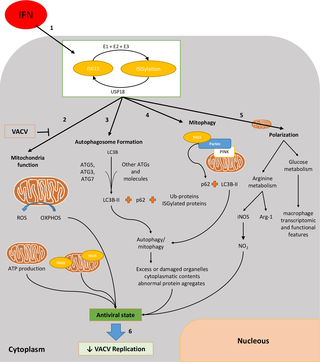PLoS Pathogens ( IF 6.7 ) Pub Date : 2017-10-27 , DOI: 10.1371/journal.ppat.1006651 Sara Baldanta , Mercedes Fernández-Escobar , Rebeca Acín-Perez , Manuel Albert , Emilio Camafeita , Inmaculada Jorge , Jesús Vázquez , José Antonio Enríquez , Susana Guerra

|
The interferon (IFN)-stimulated gene 15 (ISG15) encodes one of the most abundant proteins induced by interferon, and its expression is associated with antiviral immunity. To identify protein components implicated in IFN and ISG15 signaling, we compared the proteomes of ISG15-/- and ISG15+/+ bone marrow derived macrophages (BMDM) after vaccinia virus (VACV) infection. The results of this analysis revealed that mitochondrial dysfunction and oxidative phosphorylation (OXPHOS) were pathways altered in ISG15-/- BMDM treated with IFN. Mitochondrial respiration, Adenosine triphosphate (ATP) and reactive oxygen species (ROS) production was higher in ISG15+/+ BMDM than in ISG15-/- BMDM following IFN treatment, indicating the involvement of ISG15-dependent mechanisms. An additional consequence of ISG15 depletion was a significant change in macrophage polarization. Although infected ISG15-/- macrophages showed a robust proinflammatory cytokine expression pattern typical of an M1 phenotype, a clear blockade of nitric oxide (NO) production and arginase-1 activation was detected. Accordingly, following IFN treatment, NO release was higher in ISG15+/+ macrophages than in ISG15-/- macrophages concomitant with a decrease in viral titer. Thus, ISG15-/- macrophages were permissive for VACV replication following IFN treatment. In conclusion, our results demonstrate that ISG15 governs the dynamic functionality of mitochondria, specifically, OXPHOS and mitophagy, broadening its physiological role as an antiviral agent.
中文翻译:

ISG15控制痘苗病毒感染后巨噬细胞的线粒体功能
干扰素(IFN)刺激的基因15(ISG15)编码干扰素诱导的最丰富的蛋白质之一,其表达与抗病毒免疫力有关。为了鉴定与IFN和ISG15信号传导有关的蛋白质成分,我们比较了牛痘病毒(VACV)感染后ISG15 -/-和ISG15 + / +骨髓源性巨噬细胞(BMDM)的蛋白质组。该分析的结果表明,线粒体功能障碍和氧化磷酸化(OXPHOS)是在用IFN处理的ISG15 -/- BMDM中改变的途径。ISG15 + / +中线粒体呼吸,三磷酸腺苷(ATP)和活性氧(ROS)的产生较高IFN治疗后,BMDM比ISG15 -/- BMDM中的多,表明ISG15依赖性机制的参与。ISG15耗竭的另一个后果是巨噬细胞极化的显着变化。尽管受感染的ISG15 -/-巨噬细胞显示出典型的M1型强壮的促炎细胞因子表达模式,但仍检测到明显阻止一氧化氮(NO)生成和精氨酸酶1激活。因此,在IFN治疗后,伴随病毒滴度降低,ISG15 + / +巨噬细胞中的NO释放高于ISG15 -/-巨噬细胞中的NO释放。因此,ISG15 -/-巨噬细胞在IFN处理后被允许进行VACV复制。总之,我们的结果表明ISG15控制线粒体的动态功能,特别是OXPHOS和线粒体,从而扩大了其作为抗病毒剂的生理作用。



























 京公网安备 11010802027423号
京公网安备 11010802027423号